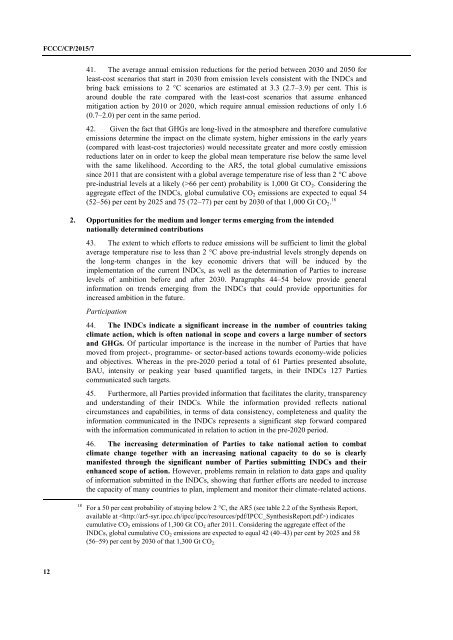FCCC/CP/2015/7
1PYuHQM
1PYuHQM
You also want an ePaper? Increase the reach of your titles
YUMPU automatically turns print PDFs into web optimized ePapers that Google loves.
<strong>FCCC</strong>/<strong>CP</strong>/<strong>2015</strong>/7<br />
41. The average annual emission reductions for the period between 2030 and 2050 for<br />
least-cost scenarios that start in 2030 from emission levels consistent with the INDCs and<br />
bring back emissions to 2 °C scenarios are estimated at 3.3 (2.7–3.9) per cent. This is<br />
around double the rate compared with the least-cost scenarios that assume enhanced<br />
mitigation action by 2010 or 2020, which require annual emission reductions of only 1.6<br />
(0.7–2.0) per cent in the same period.<br />
42. Given the fact that GHGs are long-lived in the atmosphere and therefore cumulative<br />
emissions determine the impact on the climate system, higher emissions in the early years<br />
(compared with least-cost trajectories) would necessitate greater and more costly emission<br />
reductions later on in order to keep the global mean temperature rise below the same level<br />
with the same likelihood. According to the AR5, the total global cumulative emissions<br />
since 2011 that are consistent with a global average temperature rise of less than 2 °C above<br />
pre-industrial levels at a likely (>66 per cent) probability is 1,000 Gt CO 2 . Considering the<br />
aggregate effect of the INDCs, global cumulative CO 2 emissions are expected to equal 54<br />
(52–56) per cent by 2025 and 75 (72–77) per cent by 2030 of that 1,000 Gt CO 2 . 18<br />
2. Opportunities for the medium and longer terms emerging from the intended<br />
nationally determined contributions<br />
43. The extent to which efforts to reduce emissions will be sufficient to limit the global<br />
average temperature rise to less than 2 °C above pre-industrial levels strongly depends on<br />
the long-term changes in the key economic drivers that will be induced by the<br />
implementation of the current INDCs, as well as the determination of Parties to increase<br />
levels of ambition before and after 2030. Paragraphs 44–54 below provide general<br />
information on trends emerging from the INDCs that could provide opportunities for<br />
increased ambition in the future.<br />
Participation<br />
44. The INDCs indicate a significant increase in the number of countries taking<br />
climate action, which is often national in scope and covers a large number of sectors<br />
and GHGs. Of particular importance is the increase in the number of Parties that have<br />
moved from project-, programme- or sector-based actions towards economy-wide policies<br />
and objectives. Whereas in the pre-2020 period a total of 61 Parties presented absolute,<br />
BAU, intensity or peaking year based quantified targets, in their INDCs 127 Parties<br />
communicated such targets.<br />
45. Furthermore, all Parties provided information that facilitates the clarity, transparency<br />
and understanding of their INDCs. While the information provided reflects national<br />
circumstances and capabilities, in terms of data consistency, completeness and quality the<br />
information communicated in the INDCs represents a significant step forward compared<br />
with the information communicated in relation to action in the pre-2020 period.<br />
46. The increasing determination of Parties to take national action to combat<br />
climate change together with an increasing national capacity to do so is clearly<br />
manifested through the significant number of Parties submitting INDCs and their<br />
enhanced scope of action. However, problems remain in relation to data gaps and quality<br />
of information submitted in the INDCs, showing that further efforts are needed to increase<br />
the capacity of many countries to plan, implement and monitor their climate-related actions.<br />
18 For a 50 per cent probability of staying below 2 °C, the AR5 (see table 2.2 of the Synthesis Report,<br />
available at ) indicates<br />
cumulative CO 2 emissions of 1,300 Gt CO 2 after 2011. Considering the aggregate effect of the<br />
INDCs, global cumulative CO 2 emissions are expected to equal 42 (40–43) per cent by 2025 and 58<br />
(56–59) per cent by 2030 of that 1,300 Gt CO 2.<br />
12


